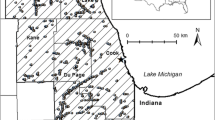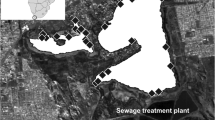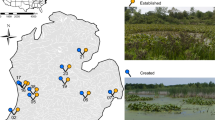Abstract
We evaluated the floristic condition of freshwater palustrine wetlands dominated by wet meadow, emergent marsh, aquatic vegetation, or open water within the rapidly urbanizing area of Portland, Oregon, USA by (1) characterizing plant species richness (presence/absence) and composition of naturally occurring wetlands (NOWs) and mitigation wetlands (MWs) and (2) identifying relationships between floristic characteristics and variables describing land-use, site conditions, and mitigation activities. Data were collected on 45 NOWs and 51 MWs. Overall species richness was high (365 plant taxa), but more than 50% of the species present on both NOWs and MWs were introduced. Only 14 species occurred on more than half the sites, and nine of them were invasive introduced species. The mean number of native species per site did not differ between land-use categories (ANOVA, F=0.62 at 3 and 88 df, p=0.6031); however, wetlands surrounded by agricultural and commercial/industrial/transportation corridor uses had more introduced species per site than wetlands surrounded by undeveloped land (Fishers Protected LSD at 88 df, p ≤ 0.05). Although overlapping in floristic composition. NOWs and MWs had significantly different (MRPP, p < 0.0001) species assemblages that were identified using TWINSPAN. MRPP analyses for all sites showed that watershed, land-use, HGM class, percent cover of water, and MW age were significantly related to the floristic composition of the study wetlands. Canonical correspondence analyses further revealed that the primary gradient for species distribution in NOWs was related to moisture; the secondary gradient was related to land-use. The primary gradient also described a strong relationship between percent cover of water and HGM class. For MWs, the primary gradient was related to watershed location and surrounding landuse; the secondary gradient was related to percent cover of water and MW age. Most MWs (44 out or 51 sites) were depressions in various settings, so while HGM class separates NOWs from MWs, it does little to distinguish MW assemblages. Our results show that wetlands in the urbanizing study area are floristically degraded. Further, current wetland management practices are replacing natural marsh and wet meadow systems with ponds, resulting in changes in the composition of plant species assemblages.
Similar content being viewed by others
Literature Cited
Administrative Rules for Oregon’s Removal-Fill Permit Program. 1986. Rules for issuance and enforcement of removal and fill permits. State of Oregon, Division of State Lands. Salem, OR, USA. OAR 141-85-005 to 141-85-090.
Andreas, B. K. and R. W. Lichvar 1995. Floristic index for establishing assessment standards: a case study for Northern Ohio. U.S. Army Corps of Engingeer Waterways Experiment Station, Vicksburg, MS, USA. Wetlands Research Program Technical Report WRP-DE-8.
Azous, A. 1991. An analysis of urbanization effects on wetland biological communitics. M.S. Thesis. University of Washington. Seattle WA, USA.
Bedford, B. L. 1996. The need to define hydrologic equivalence at the landscape scale for freshwater wetland mitigation. Ecological Applications 6:57–68.
Biondini, M. E., P. W. Mielke, and E. F. Redente: 1988. Permutation techniques based on euclidean analysis spaces: A new and powerful statistical method for ecological research. Coenoses 3:155–174.
Blair, R. B. 1996. Land use and avian species diversity along an urban gradient. Ecological Applications 6:506–519.
BONAP. 1996. A Synonymized Checklist of the Vascular Flora of the United States, Canada, and Greenland. Biota of North America Project, J. T. Kartesz, director. http://www.mip.berkeley.edu/bonap/checklist_intro.html (29 December 1998)
Booth, D. B. 1991. Urbanization and the natural drainage system: impacts, solutions, and prognoses. Northwest Environmental Journal 7:93–118.
Booth, D. B. and C. R. Jackson 1994. Urbanization of aquatic systems: degradation thresholds and the limits of mitigation. p. 425–433In R. A. Marsten and Hasfurther (eds.) Effects of Human-induced Changes on Hydrologic Systems. Proceedings: Annual Summer Symposium of American Water Resources Association. Jackson Hole, WY, USA.
Boutin, C. and P. A. Keddy. 1993. A functional classification of wetland plants. Journal of Vegetation Science 4:591–600.
Carleton, T. J., R. H. Stitt, and J. Nieppola. 1996. Constrained indicator species analysis (COINSPAN): an extension of TWINSPAN. Journal of Vegetation Science 7:125–130.
Chritensen, N. L., A. M. Baruska, J. H. Brown, S. Carpenter, C. D’Antonio, R. Francis, J. F. Franklin, J. A. MacMahon, R. F. Noss, D. J. Parsons, C. H. Peterson, M. G. Turner, and R. G. Woodmansee. 1996. The report of the Ecological Society of America committee on the scientific basis for ecosystem management. Ecological Applications 6:665–691.
Clarke, S. E., D. White and A. L. Schaedel. 1991. Oregon ecological regions and subregions for water quality management. Environmental Management 15:847–856.
Confer, S. R. and W. A. Niering. 1992. Comparison of created and natural freshwater emergent wetlands in Connecticut (USA). Wetlands Ecology and Management 3:143–156.
Cooke, S. S. and A. Azous. 1993 Effects of Urban Stormwater Runoff and Urbanization on Palustrine Wetland Vegetation, Puget Sound Wetlands and Stormwater Management Research Program. Center for Urban Water Resources Management. University of Washington, Seattle, WA, USA.
Cowardin, L. M., V. Carter, F. C. Golet, and E. T. LaRoe. 1979. Classification of wetlands and deepwater habitats of the United States. U.S. Fish and Wildlife Service. Washington, DC, USA. FWS/OBS-79/31.
Davis, M. M. 1995. Endemic wetlands of the Willamette Valley, Oregon. p. 1–8.In Studies of Plant Establishment Limitations in Wetlands of the Willamette Valley, Oregon. U.S. Army Corps of Engineers, Waterways Experiment Station, Vicksburg, MS, USA. Technical Report WRP-RE-13.
DLCD. 1992. What is an urban growth boundary? Oregon Department of Land Conservation and Development, Salem, OR, USA.
Ehrenfeld, J. G. and J. P. Schneider. 1991.Chamaecyparis thyoides wetlands and suburbanization: effects on hydrology, water quality and plant community composition. Journal of Applied Ecology 28:467–490.
Ehrenfeld, J. G. and J. P. Schneider. 1993. Response of forested wetland vegetation to perturbations of water chemistry and hydrology. Wetlands 13:122–129.
FDPEM-Portland 1999. Floristic Data for 96 Palustrine Emergent Wetlands in Portland, Oregon. United States Environmental Protection Agency. EMAP Data. http://www.epa.gov/emap
Galatowitsch, S. M. and A. G. van der Valk. 1996. The vegetation of restored and natural prairie wetlands. Ecological Applications 6:102–112.
Gauch, H. G., Jr. 1982. Multivariate Analysis in Community Ecology. Cambridge University Press, Cambridge, UK.
Gauder, C. L. and P. A. Keddy. 1995. Competitive performance and species distribution in shoreline plant communities: a comparative approach. Ecology 76:280–291.
Guard, B. J. 1995. Wetland Plants of Oregon and Washington. Lone Pine Publishing, Redmond, WA, USA.
Gwin, S. E., M. E. Kentula, and P. W. Shaffer. 1999. Evaluating the effects of wetland regulation through hydrogeomorphic classification and landscape profiles. Wetlands 19: (477–489).
Hawkes, R. B., L. Burrill, and L. J. Dennis. 1989. A Guide to Selected Weeds of Oregon (supplement), Oregon State Department of Agriculture and Oregon State University, Corvallis, OR, USA.
Hill, M. O. 1979. TWINSPAN: A Fortran Program for Arranging Multivariate Data in an Ordered Two-way Table by Classification of the Individuals and Attributes. Ecology and Systematics, Cornell University, Ithaca, NY, USA.
Hitchcock, C. L. and A. Cronquist. 1973. Flora of the Pacific Northwest. University of Washington Press. Seatle, WA, USA.
Hitchcock, C. L., A. Cronquist, and M. Ownbey. 1969. Vascular Plants of the Pacific Northwest. Part 1: Vascular Cryptograms, Gymnosperms, and Monocotyledons. University of Washington Press, Seattle, WA, USA.
Holland, C. C., J. E. Honea, S. E. Gwin, and M. E. Kentula. 1995. Wetland degradation and loss in the rapidly urbanizing area of Portland, Oregon. Wetlands 15:336–345.
Holland, C. C. and M. E. Kentula. 1992. Impacts of Section 404 permits requiring compensatory mitigation on wetlands in California (USA). Wetlands Ecology and Management 2:157–169.
Houck, C. 1996. The Distribution and abundance of invasive plant species in freshwater wetlands of the Puget-Sound Lowlands. King County, Washington. M.S. Thesis., University of Washington. Scattle, WA, USA.
Reddy, P. A., H. T. Lee, and I. C. Wisheu. 1993. Choosing indicators of ecosystem integrity: wetlands as a model system. p. 61–79.In S. Woodley, J. Kay, G. Francis (eds.) Ecological Integrity and the Management of Ecosystems. St. Lucie Press, Boca Raton, FL, USA.
Kentula, M. E., J. C. Sifneos, J. W. Good, M. Rylko, and K. Kunz. 1992a. Trends and patterns in Section 404 permitting requiring compensatory mitigation in Oregon and Washington, USA. Environmental Management 16:109–119.
Kentula, M. E., R. P. Brooks, S. E. Gwin, C. C. Holland, A. D. Sherman, and J. C. Sifneos. 1992b. An Approach to Improving Decision Making in Wetland Restoration and Creation. Island Press, Washington, DC, USA.
Kruczynski, W. L. 1990. Options to be considered in preparation and evaluation of mitigation plans. p. 555–570.In J. A. Kusler and M. H. Kentula (eds.) Wetland Creation and Restoration: The Status of the Science. Island Press, Washington, DC, USA.
Kusler, J. A. 1988. Urban wetland and urban riparian habitat: battleground or creative challenge for the 1990’s? p. 2–7.In J. A. Kusler, S. Daly, and G. Brooks (eds.) Proceedings of the National Wetland Symposium: Urban Wetlands. Association of Wetland Managers, Berne, NY, USA.
Limburg, K. E. and R. E. Schmidt. 1990. Patterns of fish spawning in Hudson River tributaries: response to an urban gradient? Ecology 71:1238–1245.
Magee, T. K., S. E. Gwin, R. G. Gibson, C. C. Holland, J. E. Honea, P. W. Shaffer, J. C. Sifneos, and M. E. Kentula. 1993. Research Plan and Methods Manual for the Oregon Wetlands Study. U.S. Environmental Protection Agency, Environmental Research Laboratory, Corvallis, OR, USA. EPA/600/R-93/072.
Magee, T. K., K. A. Dwire, S. E. Gwin, P. W. Shaffer, C. C. Holland, and J. Honea. 1995. Field and Laboratory Operations Report for the Oregon Wetlands Study. U.S. Environmental Protection Agency, Environmental Research Laboratory. Corvallis, OR, USA. EPA/600/R-95/024.
Marten, G. C. 1985. Reed canarygrass. p. 207–216.In M. E. Heath, R. F. Barnes, and D. S. Metcalfe (eds.) Forages: the Science of Grassland Agriculture. Iowa State University Press, Ames, IA, USA.
Matson, P. 1990. The use of urban gradients in ecological studies. Ecology 71:1231.
McColligan, E. T. and M. L. Kraus. 1988. Exotic plants that occur in New Jersey wetlands. p. 31–37.In J. A. Kusler, S. Daly, and G. Brooks (eds.) Proceedings of the National Wetland Symposium: Urban Wetlands. Association of Wetland Managers, Berne, NY, USA.
McCune, B. and J. Mefford. 1997. PC-ORD. Multivariate Analysis of Ecological Data, Version 3.0 For Windows. MjM Software Design, Gleneden Beach, OR, USA.
McDonnell, M. J. and S. T. A. Pickett. 1990. Ecosystem structure and function along urban-rural gradients: an unexploited opportunity for ecology. Ecology 71:1232–1237.
McIntyre, S., P. Y. Ladiges, and G. Adams. 1988. Plant species-richness and invasion by exotics in relation to disturbance of wetland communities on the Riverine Plain, NSW. Australian Journal of Ecology 113:361–373.
Medley, K. E., S. T. A. Pickett, and M. J. McDonnell. 1995. Forest-landscape structure along an urban-to-rural gradient. Professional Geographer 47:159–168.
Metro. 1997. Growth concept map. Metro 2040 Framework Update, Portland, OR, USA. Fall 1996/Winter 1997:8.
Mitsch, W. J. and R. F. Wilson. 1996. Improving the success of wetland creation and restoration with know-how, time, and self-design. Ecological Applications 6:177–183.
Myers, J. P. 1988. Wildlife and urban wetlands. p. 28–30.In J. A. Kusler, S. Daly, and G. Brooks (eds.) Proceedings of the National Wetland Symposium: Urban Wetlands, Association of Wetland Managers, Berne, NY, USA.
Naglich, F. G. 1994. Reed Canarygrass (Phalaris arundinacea L.) in the Pacific Northwest: growth parameter, economic uses, and control. Essay for Master of Environmental Studies. The Evergreen State College, Olympia, WA, USA.
Noss, R. F. and A. Y. Cooperrider. 1994. Saving Nature’s Legacy: Protecting and Restoring Biodiversity. Island Press, Washington, DC, USA.
Noss, R. F., E. T. LaRoe III, and J. M. Scott. 1995. Endangered ecosystems of the United States: a preliminary assessment of loss and degradation. U.S. National Biological Service, Washington, DC, USA. Biological Report 28.
NRC, 1995. Wetlands: Characteristics and Boundaries. National Research Council. National Academy Press, Washington, DC, USA.
Oregon State Department of Agriculture. 1994. Noxious weed policy and classification system. Noxious Weed Control Program, Oregon State Department of Agriculture, Salem, OR, USA.
Oregon Statutes. 1989. Removal-fill law. Environmental Permits Section, State of Oregon, Division of State Lands, Salem, OR, USA. O.R.S. 541, 606-541, 695 and 541.990.
Palmer, M. W. 1993. Putting things in even better order: the advantages of canonical correspondence analysis. Ecology 74:2215–2230.
Pouyat, R. V., R. W. Parmelee, and M. M. Carreiro. 1994. Environmental effects of forest soil-invertebrate and fungal densities in oak stands along an urban-rural land use gradient. Pedobiologia 38:385–399.
Reed, P. B., Jr. 1988. National List of Plant Species that Occur in Wetlands: Oregon. U.S. Fish and Wildlife Service, National Wetlands Inventory. St. Petersburg, FL, USA. Biological Report NERC-88/18.37.
Reed, P. B., Jr. 1993. Supplement to National List of Plant Species that Occur in Wetlands (Region 9). National Wetlands Inventory, U.S. Fish and Wildlife Service. http://www.nwi.fws.gov/r9suppl.txt (18 September 1996).
Rice, J. S. and B. W. Pinkerton. 1993. Reed canarygrass survival under cyclic inundation. Journal of Soil and Water Conservation 48:132–135.
Richter, K. O. and A. L. Azous. 1995. Amphibian occurrence and wetland characteristics in the Puget Sound Basin. Wetlands 15:305–312.
Rudnicky, J. L. and M. J. McDonnell. 1989. Forty-eight years of canopy change in a hardwood-hemlock forest in New York City. Bulletin of the Torrey Botany Club 116:52–64.
Schucler, T. 1994. The importance of imperviousness. Watershed Protection Techniques 1:100–111.
Shaffer, P. W., M. E. Kentula, and S. E. Gwin. 1999. Characterization of wetland hydrology using hydrogeomorphic classification. Wetlands 19:(490–504).
Sifncos, J. C., E. W. Cake, Jr., and M. E. Kentula, 1992a. Effects of Section 404 permitting on freshwater wetlands in Louisiana, Alabama, and Mississippi. Wetlands 12:28–36.
Sifneos, J. C., M. E. Kentula, and P. Price. 1992b. Impacts of Section 404 permits requiring compensatory mitigation of freshwater wetlands in Texas and Arkansas. Texas Journal of Science 44:475–485.
Simenstad, C. A. and R. M. Thom. 1996. Functional equivalency trajectories of the restored Gog-Le-Hi-Te estuarine wetland. Ecological Applications 6:38–56.
Taylor, B. L. 1993. The Influence of Wetland and Watershed Morphological Characteristics on Wetland Hydrology and Relationships to Wetland Vegetation Communities. M.S.C.E. Thesis. University of Washington, Seattle, WA, USA.
Taylor, R. J. 1990. Northwest Weeds: The Ugly and Beutiful Villains of Fiels, Gardens, and Roadsides. Mountain Press Publishing Company, Missoula, MT, USA.
ter Braak C. J. F. 1986. Canonical correspondence analysis: a new eigenvector technique for multivariate direct gradient analysis. Ecology 67:1167–1179.
ter Braak C. J. F. 1987. The analysis of vegetation-environment relationships by canonical correspondence analysis. Vegetatio 69:69–70.
ter Braak, C. J. F. 1988. CANOCO-a FORTRAN Program for Canonical Community Ordination by [Partial] [Detrended] [Canonical] Correlation analysis, Principal components analysis, and Redundancy analysis (version 2.1). TNO Institute of Applied Computer Science, Wagcningen, The Netherlands.
ter Braak, C. J. E. 1990. Update notes: CANOCO version 3.10. Agricultural Mathematics Group, Wageningen, The Netherlands.
ter Braak, C. J. F. and P. F. M. Verdonschot. 1995. Canonical correspondence analysis and related multivariate methods in aquatic ecology. Aquatic Science 57:255–289.
U.S. Congress, Office of Technology Assessment. 1993. Harmful Non-indigenous Species in the United States. U.S. Government Printing Office, Washington, DC, USA. OTA-F-565.
U.S. Department of the Army and U.S. Environmental Protection Agency. 1990. Unpublished memorandum of agreement concerning the determination of mitigation under the Clean Water Act Section 404 (b) (1) guidelines, p. 5–6. Washington, DC, USA.
van Sickle, J. 1997. Using mean similarity dendrograms to evaluate classifications. Journal of Agricultural, Biological, and Environmental Statistics 2:370–388.
Washington State Department of Agriculture. 1992. Plant Quarantine Manual. Plant Sciences Division, Washington State Department of Agriculture, Seattle, WA, USA.
Weinmann, F., M. Boulé, K. Brunner, J. Malek, and V. Yoshino. 1984. Wetland Plants of the Pacific Northwest. U.S. Army Corps of Engineers, Seattle District, Seattle, WA, USA.
Whitson, T. D., L. C. Burril, S. A. Dewey, D. W. Cudney, B. E. Nelson, R. D. Lee, and R. Parker 1996. Weeds of the West. University of Wyoming, Pioneer of Jackson Hole, WY, USA.
Wilson, M. V., C. A. Ingersoll, and M. G. Wilson. 1995. Pest plant and seed bank reduction. p. 9–24.In Studies of Plant Establishment Limitations in Wetlands of the Willamette Valley, Oregon. Wetlands Research Program. U.S. Army Engineer Waterways Experiment Station, U.S. Army Corps of Engineers, Vicksburg, MS, USA. Technical Report WRP-RE-13.
Zimmerman, G. M., H. Goetz and P. W. Mielke, Jr. 1985. Use of an improved statistical method for group comparisons to study effects of prairie fire. Ecology 66:606–611.
Author information
Authors and Affiliations
Corresponding author
Rights and permissions
About this article
Cite this article
Magee, T.K., Ernst, T.L., Kentula, M.E. et al. Floristic comparison of freshwater wetlands in an urbanizing environment. Wetlands 19, 517–534 (1999). https://doi.org/10.1007/BF03161690
Received:
Revised:
Accepted:
Issue Date:
DOI: https://doi.org/10.1007/BF03161690




